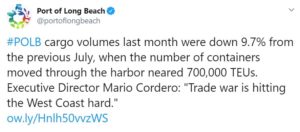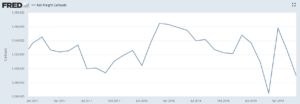Trump’s
Trade Mayhem Hurts The Working-Class People He Claims To Love
 |
| The cost of Trump's trade tax (tariffs) on Rhode Island and the rest of the country. Source: Center for American Progress. |
His gratuitous trade mayhem is damaging the global economy.
That means workers in jobs requiring no more than a high school
diploma may soon get let go from jobs moving goods.
Longshoremen, railroad
workers, teamsters, the lumpers who load trailers, warehouse workers, and
retail clerks are all at risk of being forced into unemployment.
Will these millions of workers grasp that Trump is abusing them
to satisfy his whims? Or will they react more like battered spouses who keep
returning for more abuse because they cannot see the harsh reality of their
situation?
During the 2016 primary races, Trump declared “I love the poorly
educated.” At rally after rally he used the word “love” to sell the idea that
he would champion what he later called the “forgotten man.”
Trump’s
actions worsen the safety, health and long term financial interests of workers,
while being a lucrative boon to polluters and financial predators.
As we have documented again and again at DCReport.org, Team Trump’s actions worsen
the safety, health and long term financial interests of workers, while being a
lucrative boon to polluters and financial predators.
It was easy for Trump, the most successful con artist in
history, to trick the poorly educated. Trade is a complex issue whose costs and
benefits keep economics professors with doctoral degrees busy debating.
 No one reasonably expects people with a General Education
Development (GED) certificate or a high school diploma to grasp what Trump
clearly doesn’t understand: when a worker in Shanghai loses her job, it may
cost a worker in Shreveport hers.
No one reasonably expects people with a General Education
Development (GED) certificate or a high school diploma to grasp what Trump
clearly doesn’t understand: when a worker in Shanghai loses her job, it may
cost a worker in Shreveport hers.
Like it or not, we live in a global economy with complex supply
chains that make all those in major economies dependent on one another. Smart
diplomacy can improve the global trade rules, but tariffs and tirades cannot.
What
Tariffs Cost Americans
Trump’s tariffs are expected to cost American households
an average of $831 this year.
Trump’s rash move on Friday, Aug. 23, to increase tariffs and apply them to even more Chinese goods, taken in response to retaliatory Chinese tariffs on American goods, is likely to push that cost well above $1,000 per American household.
That’s a lot of money for the poorly educated – more than a
week’s gross pay. Our federal government estimates typical truck driver pay at $44,000, though
typical pay is significantly lower in Southern states (and Idaho), that went
for Trump in 2016. Retail sales clerks typically make
only $24,340.
Exposing his own ignorance, and clearly hoping that the poorly
educated can be fooled again, Trump keeps saying that China is paying the tariffs.
In fact,
as anyone who has taken a single college economics course knows, a tariff is a
tax on consumers, so it is Americans who pay, not the Chinese.
Since America buys only one-fifth of China’s exports, the damage
from Trump’s trade mayhem will hurt Americans in trade-related jobs more than
the Chinese.
China, to be sure, is hurting because of the Trump trade mayhem.
Chinese factory activity began declining in May. But contrast that with
America, where 14 months ago orders for goods for export began declining.
Americans who vote have the power to decide who makes the rules
they must live by, while the Chinese are vassals of a brutal communist
dictatorship that does not hesitate to massacre its own people when necessary
to maintain its power.
That means President Xi and his team can make their
people endure for as long as it takes to prevail in Trump’s trade war.
China has fallen this year from first place to third as an
American trading partner. Mexico is now first in goods, Canada second. China trade is
down about 10%, compared to the first half of 2018.
The decline in trade with China means fewer ships crossing the
Pacific laden with goods. That, in turn, means in the months ahead fewer jobs
moving cargo at seaports, at railroads, at trucking firms and, eventually, at
retail stores.
Signs of Decline
American rail freight traffic is down about 3% through mid-August and, revealingly, down 5% for the most
recent week, according to the American Association of Railroads.
Canadian traffic, however, is up 2%.
California’s Long Beach Port is a key indicator of foreign goods
trade. The number of arriving cargo containers was down 10% from a year earlier, the lowest July import volume
since 2014.
The Port of Los Angeles shows increased container shipments this
year, but is down 12.4% from 2017, another indicator of Trump’s trade
mayhem.
Then there are orders for new big rig trucks, known as Class 8
trucks, an indicator of expected trucking volume in 2020 and beyond. Class 8
sales this year have collapsed, down 81% by one measure. That means workers who build big rigs
and diesel engines may face layoffs starting later this year.
By deferring new truck purchases, trucking company owners reduce
their risk of bankruptcy in a recession, which may already have started.
The global economic slowdown has also hit Germany, which had
been the main engine of European Union activity.
A telling perspective on what
is coming emerged in a recent conference call between Stuttgart-based
executives of Daimler, famous for its luxury Mercedes-Benz cars, and stock
market analysts.
Daimler revealed a 70% drop in orders for new trucks in North America, which
overwhelmingly means the United States.

Monthly rail freight-car loads (Federal Reserve Bank of St.
Louis)
Ola Källenius, the CEO of Daimler, told stock analysts in July
about where future growth lies.
He cited Brazil, adding “we believe in
long-term growth in China. It’s one of the main pillars of our market growth
strategy in the long-term. So, China, for us is important and it’s a market
that will continue to invest in and also gradually increase our production
capacity.”
And what about the United States? “The 2020 numbers in
North America will be lower than 2019 numbers,” said Martin Daum, the Daimler
executive in charge of truck and bus manufacturing.
The questions we need to ask ourselves? Will the poorly educated
grasp that Trump’s trade mayhem is the sand tearing up the gears of world
commerce or will he trick them, again, into believing that he alone can solve
their pocketbook problems? And how do we educate these voters?